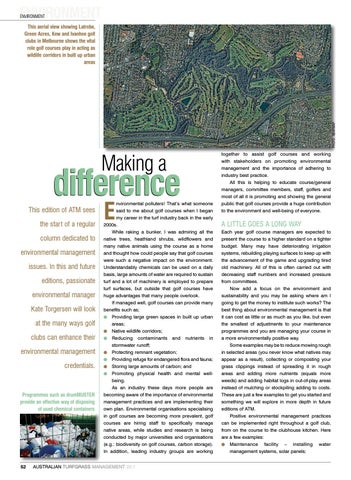ENVIRONMENT ENVIRONMENT
PHOTO: NEARMAP
This aerial view showing Latrobe, Green Acres, Kew and Ivanhoe golf clubs in Melbourne shows the vital role golf courses play in acting as wildlife corridors in built up urban areas
Making a
difference This edition of ATM sees the start of a regular column dedicated to environmental management issues. In this and future editions, passionate environmental manager Kate Torgersen will look at the many ways golf clubs can enhance their environmental management credentials.
Programmes such as drumMUSTER provide an effective way of disposing of used chemical containers
52
E
nvironmental polluters! That’s what someone said to me about golf courses when I began my career in the turf industry back in the early 2000s. While raking a bunker, I was admiring all the native trees, heathland shrubs, wildflowers and many native animals using the course as a home and thought how could people say that golf courses were such a negative impact on the environment. Understandably chemicals can be used on a daily basis, large amounts of water are required to sustain turf and a lot of machinery is employed to prepare turf surfaces, but outside that golf courses have huge advantages that many people overlook. If managed well, golf courses can provide many benefits such as; l Providing large green spaces in built up urban areas; l Native wildlife corridors; l Reducing contaminants and nutrients in stormwater runoff; l Protecting remnant vegetation; l Providing refuge for endangered flora and fauna; l Storing large amounts of carbon; and l Promoting physical health and mental wellbeing. As an industry these days more people are becoming aware of the importance of environmental management practices and are implementing their own plan. Environmental organisations specialising in golf courses are becoming more prevalent, golf courses are hiring staff to specifically manage native areas, while studies and research is being conducted by major universities and organisations (e.g.: biodiversity on golf courses, carbon storage). In addition, leading industry groups are working
AUSTRALIAN TURFGRASS MANAGEMENT 20.1
together to assist golf courses and working with stakeholders on promoting environmental management and the importance of adhering to industry best practice. All this is helping to educate course/general managers, committee members, staff, golfers and most of all it is promoting and showing the general public that golf courses provide a huge contribution to the environment and well-being of everyone.
A LITTLE GOES A LONG WAY Each year golf course managers are expected to present the course to a higher standard on a tighter budget. Many may have deteriorating irrigation systems, rebuilding playing surfaces to keep up with the advancement of the game and upgrading tired old machinery. All of this is often carried out with decreasing staff numbers and increased pressure from committees. Now add a focus on the environment and sustainability and you may be asking where am I going to get the money to institute such works? The best thing about environmental management is that it can cost as little or as much as you like, but even the smallest of adjustments to your maintenance programmes and you are managing your course in a more environmentally positive way. Some examples may be to reduce mowing rough in selected areas (you never know what natives may appear as a result), collecting or composting your grass clippings instead of spreading it in rough areas and adding more nutrients (equals more weeds) and adding habitat logs in out-of-play areas instead of mulching or stockpiling adding to costs. These are just a few examples to get you started and something we will explore in more depth in future editions of ATM. Positive environmental management practices can be implemented right throughout a golf club, from on the course to the clubhouse kitchen. Here are a few examples: l Maintenance facility – installing water management systems, solar panels;
